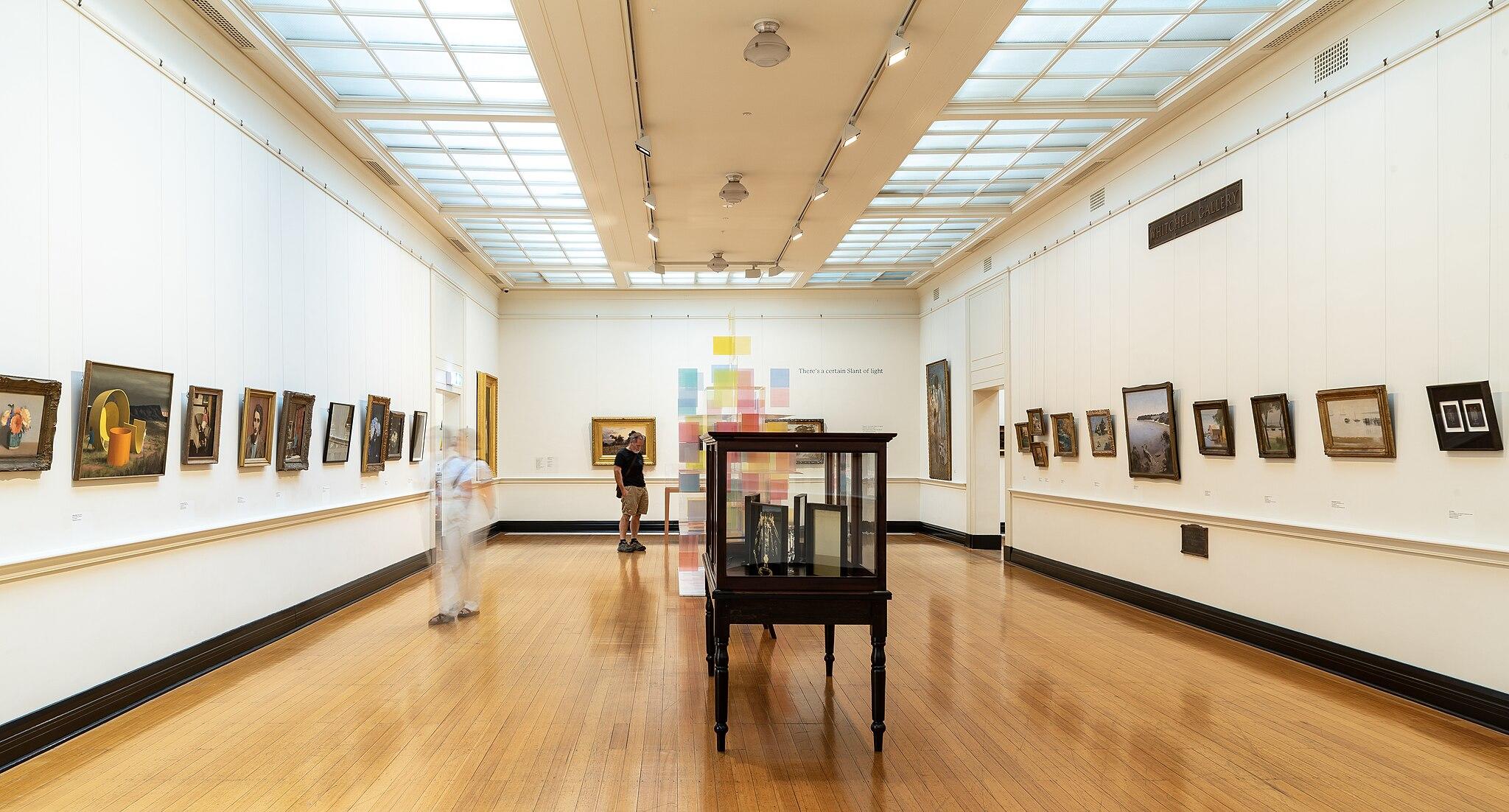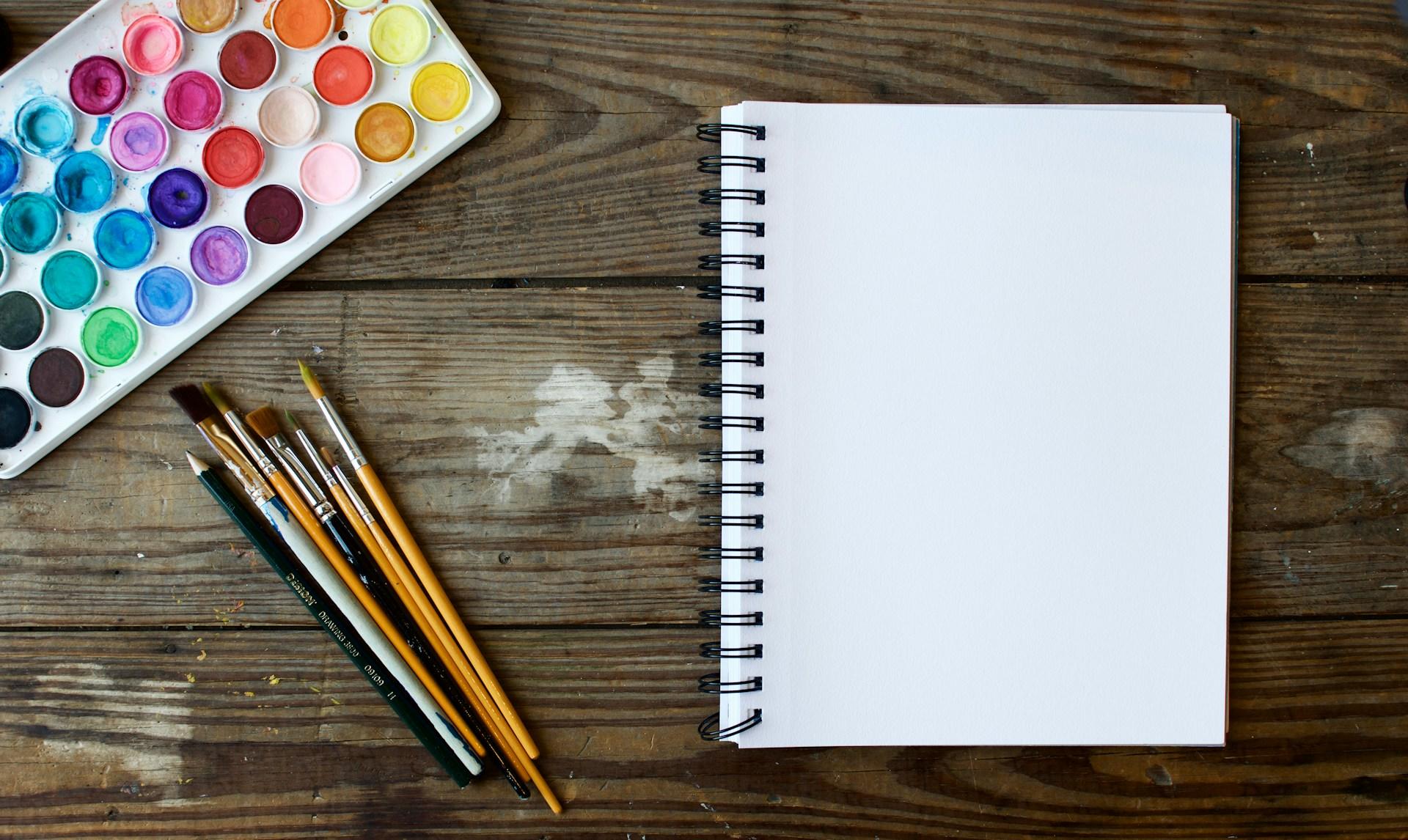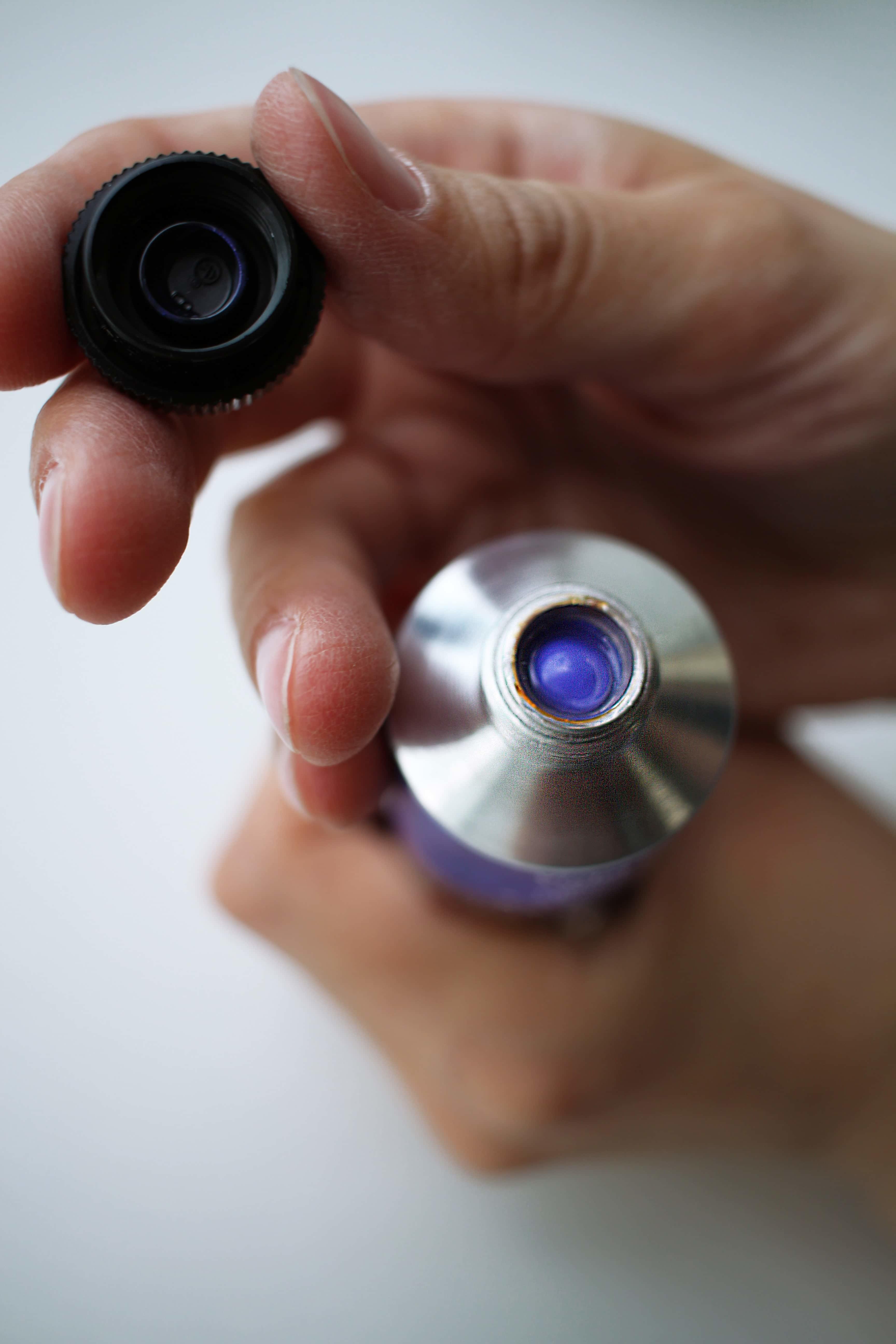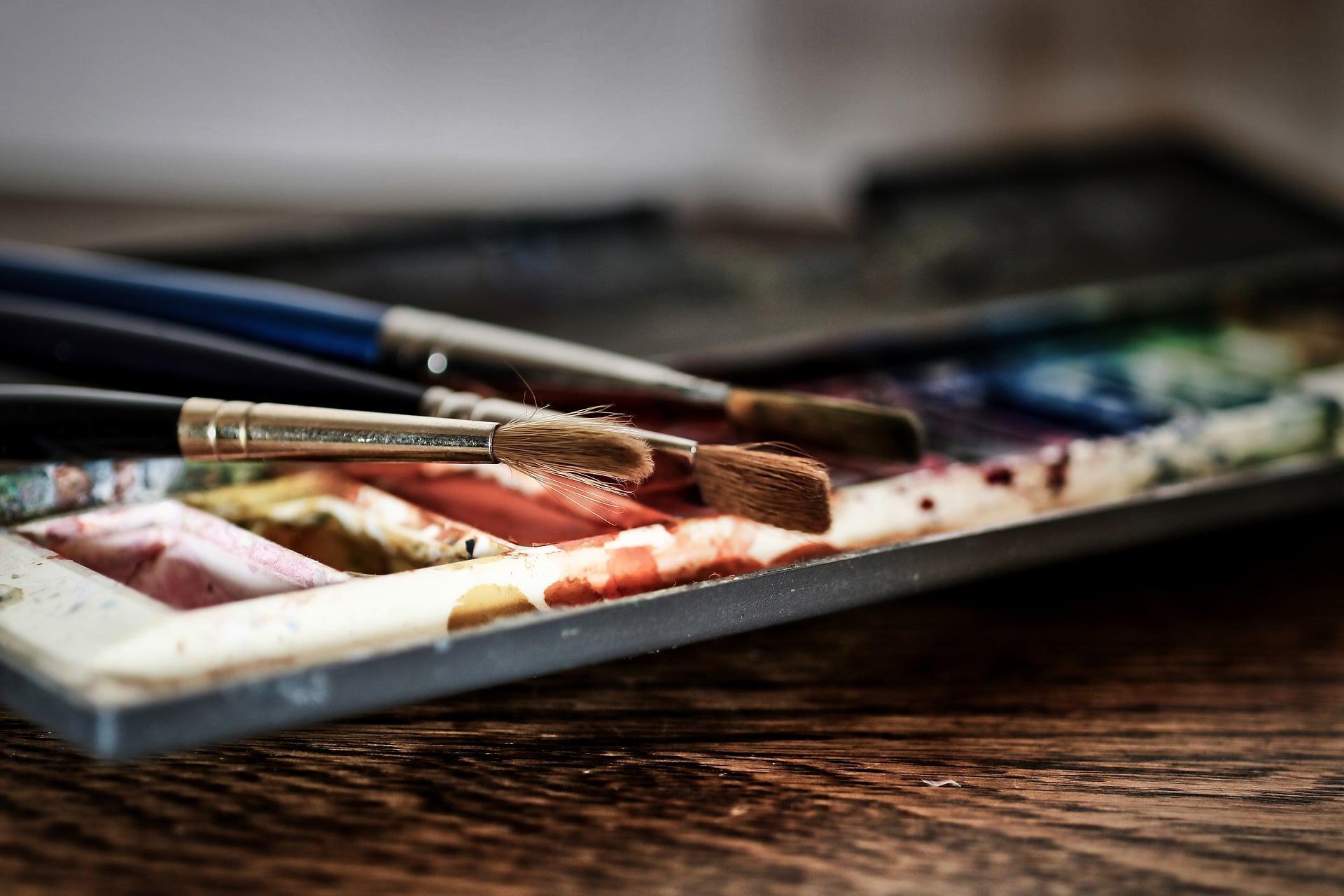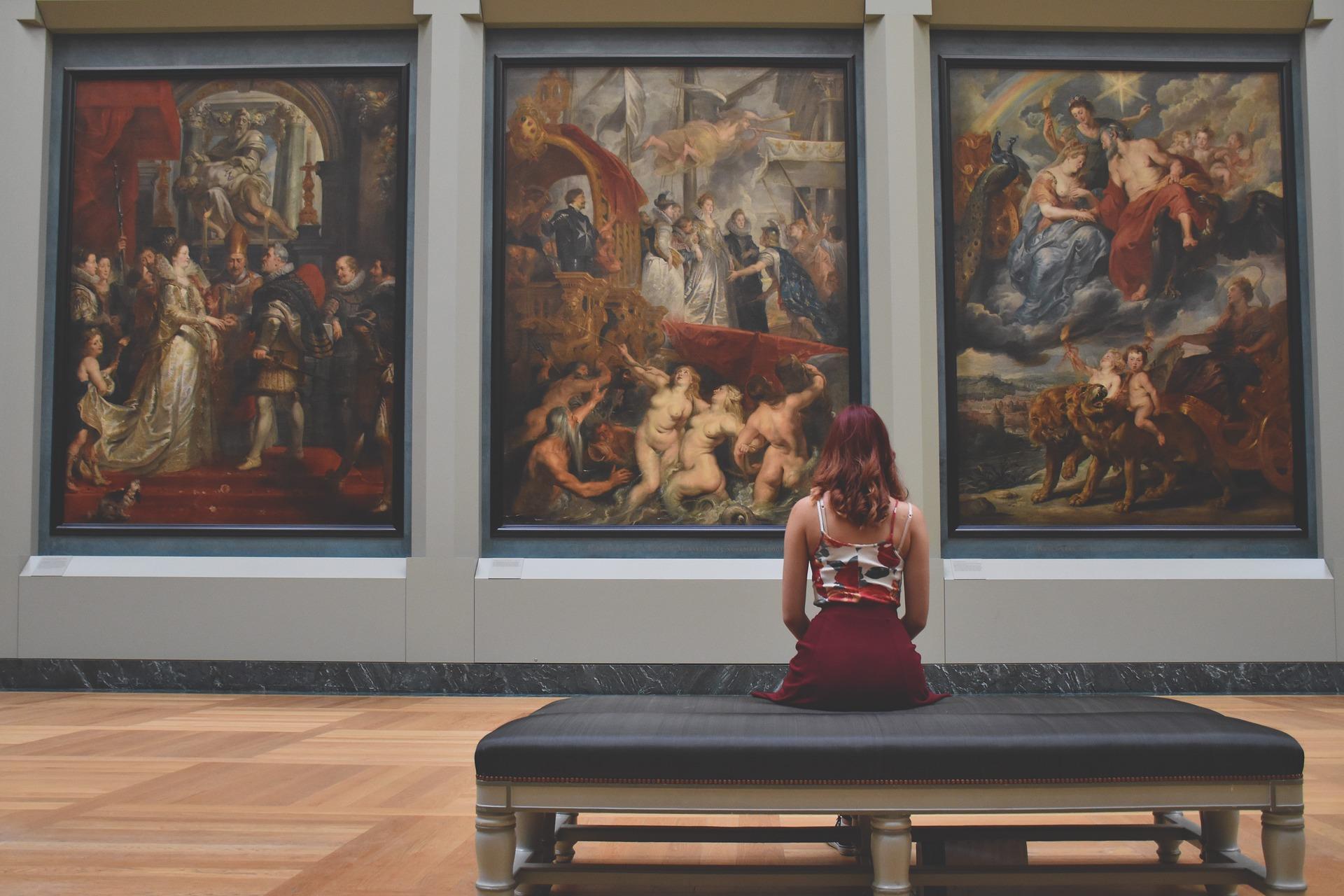Australia’s history is long and storied, and its art history is particularly fascinating and unique. From the ancient traditions of Aboriginal art, to the colonists, to modern and contemporary movements, Australia’s history of painted artworks provides a lot of information for people interested in history.
Let’s cover a brief history of Australia’s storied artistic chronicles, learning about the major art movements and famous artists along the way.

Indigenous Australian Art (c. 65,000BCE - 1788CE)
Aboriginal art is one of the oldest continuous artistic traditions in the world, dating back tens of thousands of years. It served as a means of storytelling, spiritual expression, and connection to the land, with art forms including Australian wall art which consisted of rock paintings and carvings, bark paintings, and sand drawings. While traditionally non-figurative, Aboriginal art often uses symbols and patterns to convey profound spiritual and cultural meanings, including Dreaming.
These ancient paintings typically used mediums like ochre, charcoal, and chalk, combined with a binding agent to create a wet paint.

The oldest known examples of Indigenous Australian art are about 28,000-30,000 years old! The oldest artwork with a known interpretation is the Bunjil painting in Southern Victoria, which depicts Bunjil, the main Dreaming Being of south-eastern Australia. All other ancient artworks are left open to speculation (at least by outsiders).
Amazingly, because modern-day Aboriginal people still have connections to their ancestral heritage, traditional painting techniques and more are still present! Some Aboriginal people have learned from their ancestors how to paint in the same tradition as thousands of years ago. As a result, we now have modern paintings in this ancient style, as well as paintings inspired by the ancient style but with a modern flair.
Beginning in the 19th century, acrylic paints and other media were introduced, which allowed Aboriginal artists to paint with sturdier media. Some chose to continue using the traditional colour palette of black, white, and ochre, while others embraced new, bright, vivid colours.
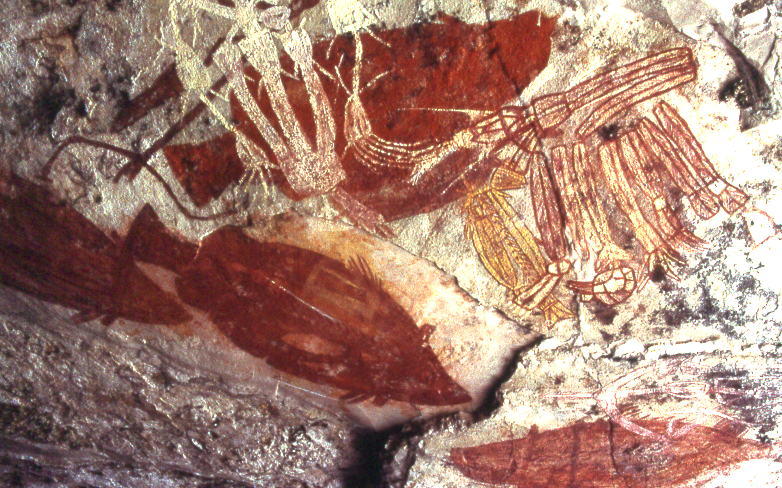
Australian Colonial Art (1788–1850s)
Colonial art emerged with European settlement in 1788, documenting Australia’s unfamiliar landscapes, flora, and fauna. Artists primarily sought to capture the exotic beauty of the new land and the experiences of settlers. Using watercolours, the artists at this time were mostly involved in scientific documentation, so most paintings in this movement are botanical illustrations or similar.
The earliest artists sought to portray the exotic features in the new land for documentation purposes and to bring the findings back to Europe. It wasn’t until settlements became more established that some classically trained artists started painting from an artistic, rather than scientific, viewpoint.
However, they still had a mostly documentarian aesthetic. By far, the most-used medium at this time was watercolour.
Notable Painters and Works
The artists at this time are best known for working to understand the local landscape on a visual level and share the amazing, unique colours and environments with the world. Australian landscape art has also been very important in history for understanding what the landscape looked like before colonial development took hold and for gaining insight into how settlers saw the ‘new world.’
John Glover (1767–1849)
John Glover was an English-born landscape painter who became one of Australia’s most prominent colonial artists. Known as "the father of Australian landscape painting," he captured the country’s natural beauty and unique light with precision. Works like A View of the Artist’s House and Garden, Mills Plains reveal his fusion of European pastoral traditions with the untamed Australian wilderness.
Some of his most important works include:
- A View of the Artist’s House and Garden, Mills Plains (1835)
- Natives on the Ouse River, Van Diemen’s Land (1838)
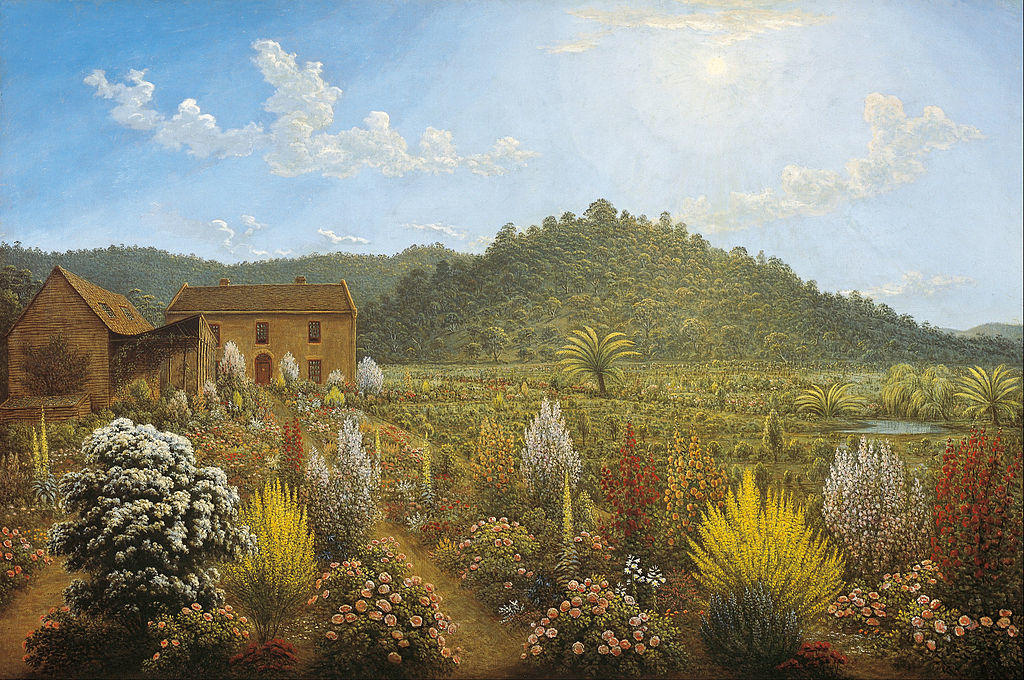
Conrad Martens (1801–1878)
Conrad Martens was a British-born artist renowned for his Romantic depictions of Australia’s landscapes. Arriving in Sydney in 1835, he created evocative works like View of Sydney Cove, showcasing the sublime beauty of the Australian coastline. Martens’ delicate use of light and composition made him a key figure in colonial Australian art.
A few of his most notable paintings include:
- View of Sydney Cove (1848)
- Middle Habour (1876)

Eugene von Guérard (1811–1901)
Eugene von Guérard was an Austrian-born artist and a master of landscape painting in colonial Australia. His works, such as North-east View from the Northern Top of Mount Kosciuszko, combine scientific detail with artistic grandeur. Von Guérard’s commitment to accurately portraying Australia’s natural environment cemented his reputation as a leading figure in 19th-century Australian art.
He is known for works such as:
- North-east View from the Northern Top of Mount Kosciuszko (1863)
- Tower Hill (1855)

Albert Namatjira (1902–1959)
Even though he technically didn’t participate in the Colonial movement while it was happening, Namatjira learned painting from white artist Rex Battarbee.
As a result, his style was similar to the European style, and therefore the colonist style.
However, his specific view rendered his works different from the typical colonial style, making him a bridge between Aboriginal art, colonial art, and modern art. Specifically, he was part of the Hermannsburg School movement.
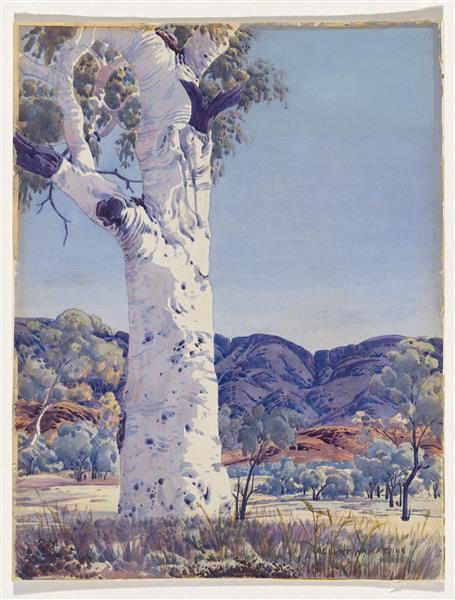
He became one of Australia’s most celebrated painters of all time. Some of his most famous paintings include:
- Ghost Gum, Central Australia (1951)
- Palm Valley (1940s)
The Heidelberg School (1880s–1900s)
The Heidelberg School, often called Australian Impressionism, marked the birth of a distinct national art style. Inspired by French Impressionism, these artists depicted Australian light, landscapes, and rural life with a sense of immediacy and authenticity, versus the soft romanticism of colonial art.
Notable Painters and Works
There were five main characters in the Heidelberg School who created the movement by establishing ‘artists’ camps’ in the rural suburban areas near Melbourne and focused on creating their art and helping each other develop. Three of the men are listed here.
Tom Roberts (1856–1931)
Tom Roberts was a key figure in the Heidelberg School, celebrated for his iconic depictions of rural Australian life including pioneers and the bush.
He is known for:
- Shearing the Rams (1890)
- The Golden Fleece (1894)
Arthur Streeton (1867–1943)
Arthur Streeton is remembered for his luminous landscapes. Paintings such as Golden Summer, Eaglemont showcase his mastery of light and the Australian countryside's unique beauty.
Some of his most famous paintings are:
- Golden Summer, Eaglemont (1889)
- Fire’s On (1891)
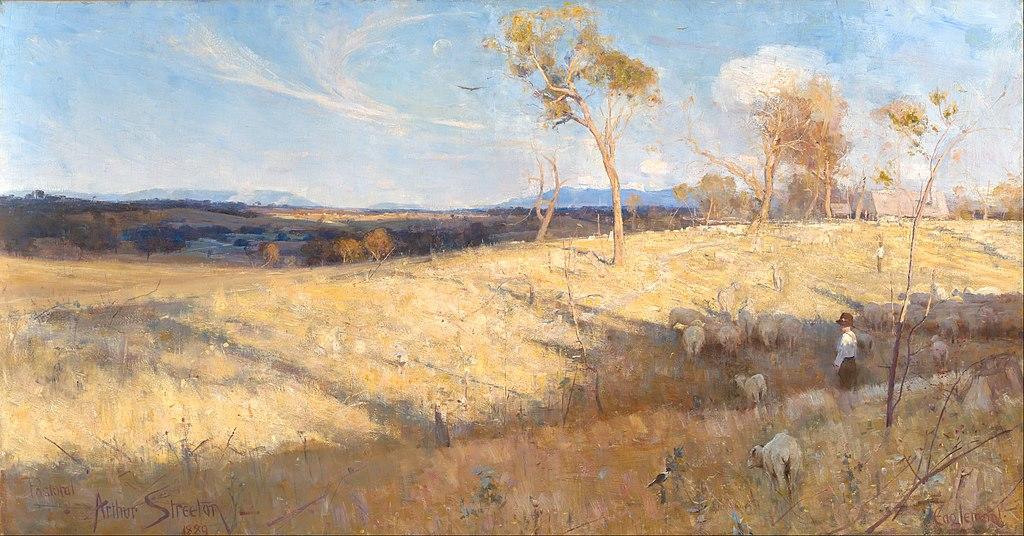
Frederick McCubbin (1855–1917)
Frederick McCubbin is known for his poignant depictions of pioneer life. Works like The Pioneer capture themes of settlement, survival, and human connection to the land.
His body of work includes:
- The Pioneer (1904)
- On the Wallaby Track (1896)

Symbolism, Post-Impressionism, and Modernism (1900s–1940s)
Following the Heidelberg School, Australian artists began experimenting with Post-Impressionism and Symbolism, exploring emotional and symbolic content. These styles marked a shift toward more personal and imaginative expressions. While Symbolism was a minor blip in the art-sphere, Post-Impressionism was an important stepping-stone to Modernism.
Symbolist art at the time was nearly indistinguishable from Art Nouveau in a lot of ways.
According to many art historians, the first Australian Post-Impressionist work was The Sock Knitter (1915) by Grace Cossington Smith. Post-Impressionism and Modernism in Australia were essentially one and the same, instead of having an obvious gap between the two movements.
Modernism arrived in Australia during the interwar years, as artists absorbed influences from European movements like Abstraction, Cubism, Surrealism, and Fauvism. This period saw an explosion of experimentation and the rise of abstraction.
Notable Painters and Works
Painters in this era helped propel (white-styled) Australian art from strictly realistic depictions to more imaginative and interpretive art. Their use of colour and form became a controllable element with deeper meanings behind them.
George Lambert (1873–1930)
George Lambert was an acclaimed Australian painter and sculptor known for his vivid portraits and historical scenes.
Some famous paintings:
- The Squatter’s Daughter (1924)
- Anzac, the Landing 1915 (1922)

Margaret Preston (1875–1963)

Margaret Preston was a modernist painter and printmaker who was celebrated for her bold, decorative works inspired by Australian flora and Indigenous art.
Some famous paintings:
- Flannel Flowers (1938)
- Implement Blue (1927)
Elioth Gruner (1882–1939)
Elioth Gruner was a landscape artist renowned for capturing the serenity of rural Australia.
Some famous paintings:
- Spring Frost (1919)
- Morning Light (1916)
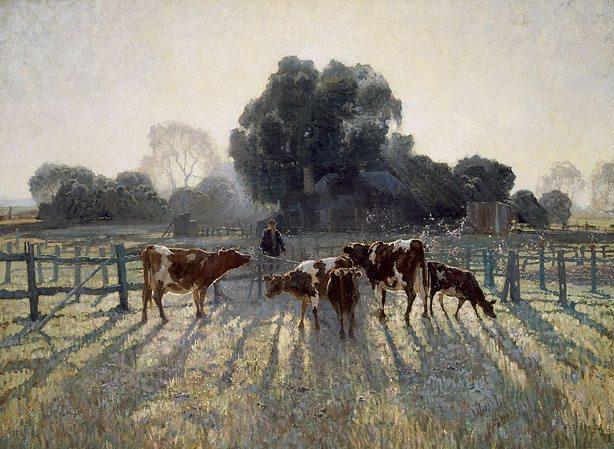
Grace Crowley (1890–1979)
Grace Crowley was a pioneer of abstract art in Australia, blending Cubist influences with her distinct vision.
Some famous paintings:
- Abstract (1953)
- Sailors and models (1928)
Ralph Balson (1890–1964)
Ralph Balson was a trailblazer in Australian abstraction, creating geometric and non-representational works with intellectual and minimalist aesthetics.
Some famous paintings:
- Painting (1951)
- The Sisters (family group) (1939)
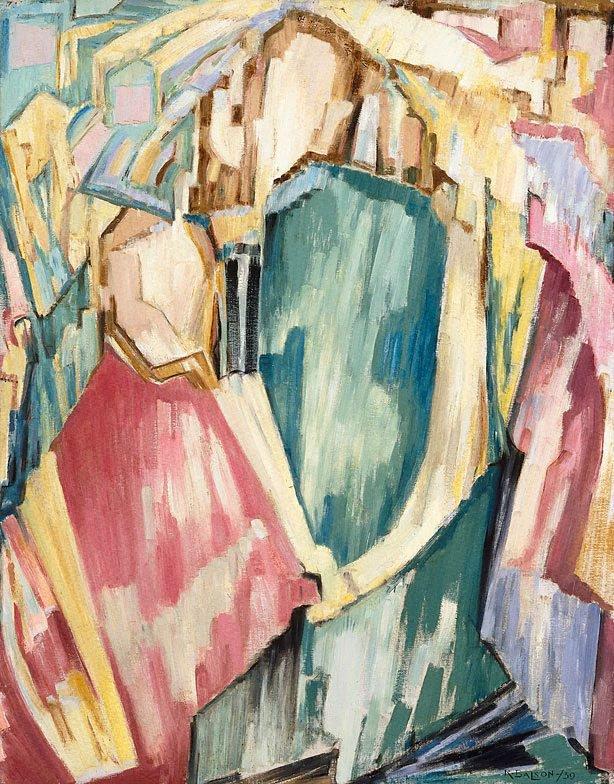
Sidney Nolan (1917–1992)
Sidney Nolan was one of Australia’s most celebrated modernist painters, known for his iconic depictions of historical national stories and folklore.
Some famous paintings:
- Ned Kelly series (1946-47)
- Burke and Wills Expedition, ‘Gray Sick’ (1949)
The Antipodeans (1950s–1960s)
The Antipodeans was a collective of Australian painters who opposed the dominance of abstract art, emphasizing the importance of figurative painting. Their work often explored human themes with a focus on storytelling.
Notable Painters and Works
Painters in the Antipodeans movement sometimes created surreal and abstract works, but ones that were narrative in nature.
Arthur Boyd (1920–1999)
Arthur Boyd was a versatile artist whose works combined figurative and symbolic elements to explore themes of exile, human emotion, and the Australian environment.
- The Expulsion (1948)
John Brack (1920–1999)
John Brack created poignant and satirical depictions of Australian urban life, with iconic works like The Bar reflecting the monotony and complexity of modern existence.
- Collins St., 5 p.m. (1955)
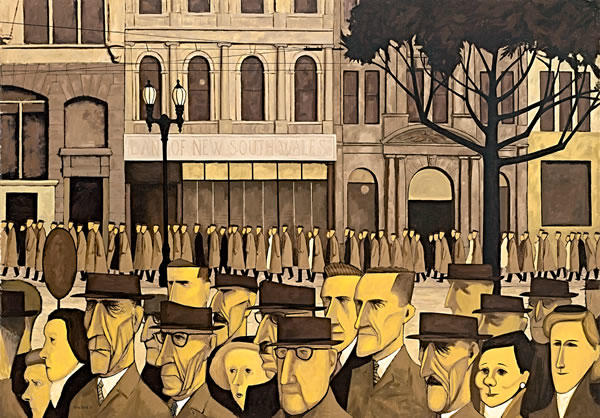
Charles Blackman (1928–2018)
Charles Blackman is renowned for his dreamlike, emotionally evocative works which often depict themes of isolation and imagination.
- The Schoolgirl series (1952-55)
Contemporary Indigenous Art (1970s–Present)
Contemporary Indigenous art emerged as a powerful movement in the late 20th century, blending traditional techniques with modern mediums and addressing themes of identity, land, and cultural resilience.
Notable Painters and Works
While the names of the ancient artists have been lost to time, there are plenty of recent Aboriginal artists who have created works that are very similar to the ancient painting techniques.
Artists in this movement use a variety of media, rather than just the traditional materials like ochre and charcoal.
Here are just some of the many Aboriginal artists utilising traditional methods to know about!
Emily Kame Kngwarreye (1910–1996)
Emily Kame Kngwarreye was a pioneering Aboriginal artist from the Utopia region in Central Australia. Her vibrant, abstract paintings drew on her deep spiritual connection to the land and its Dreaming stories. Starting her artistic career late in life, she became one of Australia’s most celebrated painters. She turned to painting only in her 70s after the process of working with batik became too difficult in her older age.
Her work is specifically part of the Western Desert Art Movement, aka Dot Painting.
Some of her most well-known works include:
- Big Yam Dreaming (1995)
- Earth’s Creation (1994)

Jeannie Mills Pwerle (1965-present)
Jeannie Mills Pwerle, the great-niece of Emily Kame Kngwarreye, is an Indigenous artist from the Utopia region in Central Australia, renowned for her intricate dot paintings.
She often portrays Dreaming stories, particularly the Bush Yam series, which celebrates the sacred connection between her community and the yam plant.
Her work is characterized by its rhythmic patterns and vivid colours, which reflect her cultural heritage and artistic innovation.
She is most well-known for her Yam Dreaming series, which she began painting in the 1990s and still paints today.
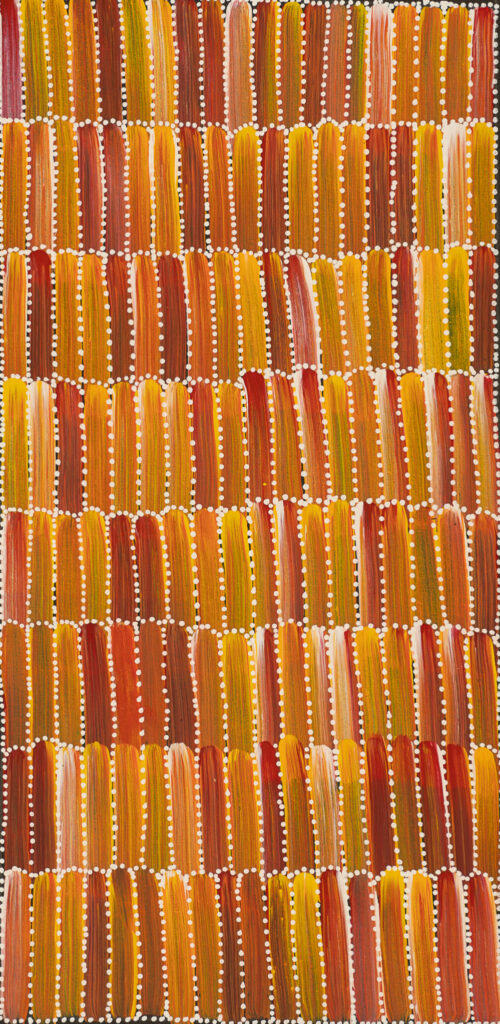
Clifford Possum Tjapaltjarri (1932–2002)
Clifford Possum was a renowned Aboriginal artist whose intricate dot paintings conveyed Dreaming narratives and cultural heritage with profound detail and symbolism.
Known for:
- Warlugulong (1976)
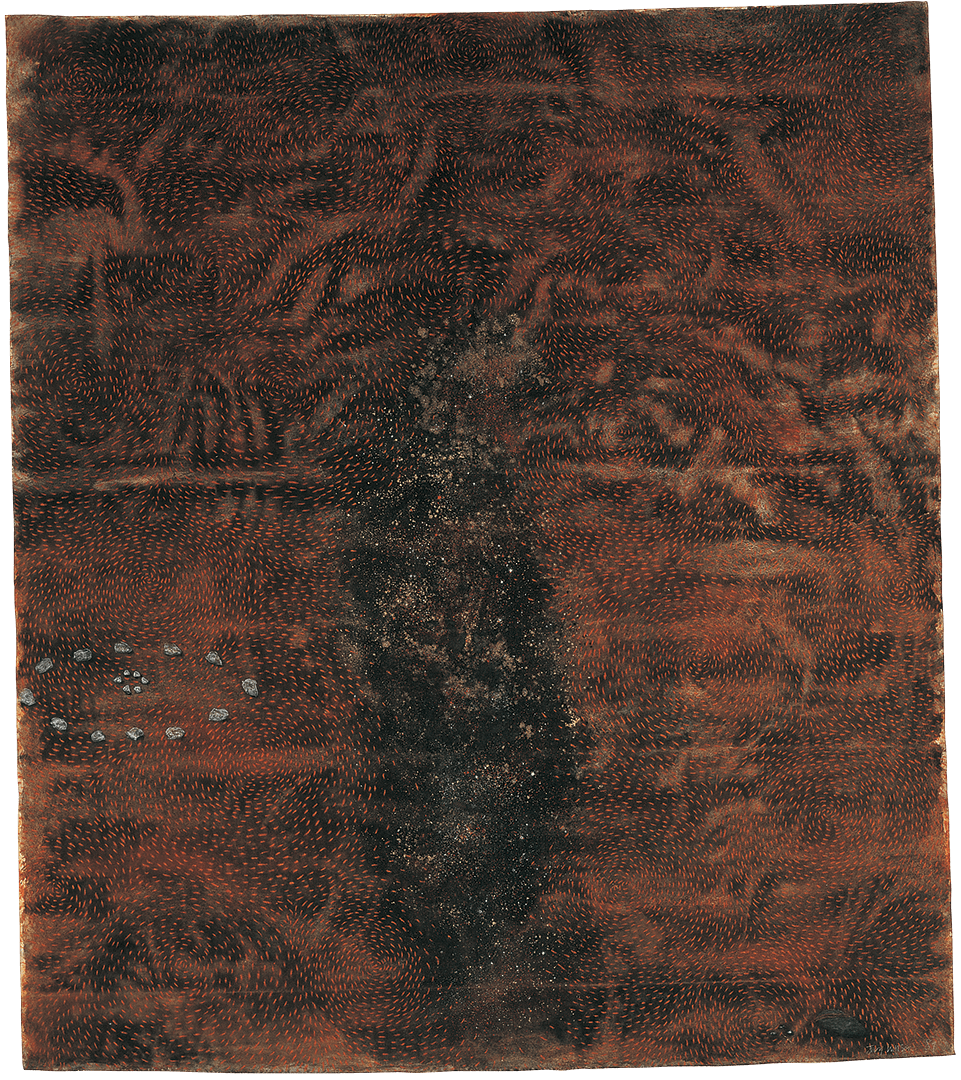
Known for:
Lin Onus (1948–1996)
Lin Onus was a trailblazing artist who blended Indigenous motifs with Western artistic styles and often blended humour and reflection together.
Known for:
- Fruit Bats (1991)
Rover Thomas (c.1926–1998)
Rover Thomas was a prominent Aboriginal artist from Western Australia and a key figure in the contemporary Indigenous art movement.
His minimalist, earthy paintings often depicted Dreaming stories and historical events, such as Cyclone Tracy. Thomas’s unique style combined traditional cultural stories with modern artistic expression, earning him international acclaim.
Some of his most famous works include:
- Cyclone Tracy (1991)
- Roads Meeting (1987)
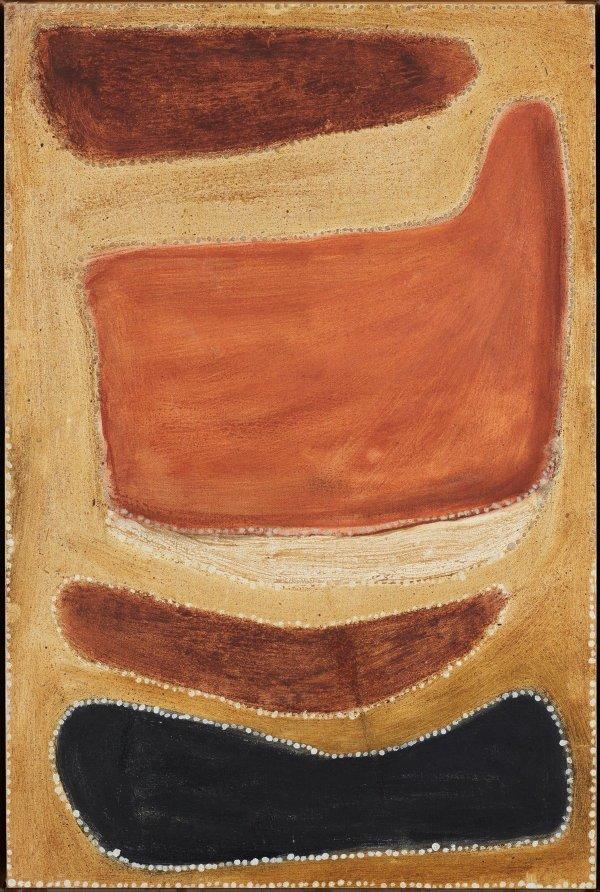
Contemporary Art (1980s–Present)
Contemporary Australian painting reflects a globalized, multicultural world, with artists addressing issues like identity, environment, and technology. The movement embraces a wide range of styles, from hyperrealism to abstraction.
Notable Painters and Works
Contemporary art has many forms and seeks to accomplish many different goals. Some art is for art’s sake while others are sociopolitical commentary, for example.
Del Kathryn Barton (b. 1972)
Del Kathryn Barton is known for her vibrant, intricately detailed paintings which explore themes of femininity, love, and human connection.
Known for:
- You Are What Is Most Beautiful About Me a self-portrait with Kell and Arella (2000)
Ben Quilty (b. 1973)
Ben Quilty’s expressive, emotionally charged works address social and political issues.
Known for:
- Captain S, after Afghanistan (2012)
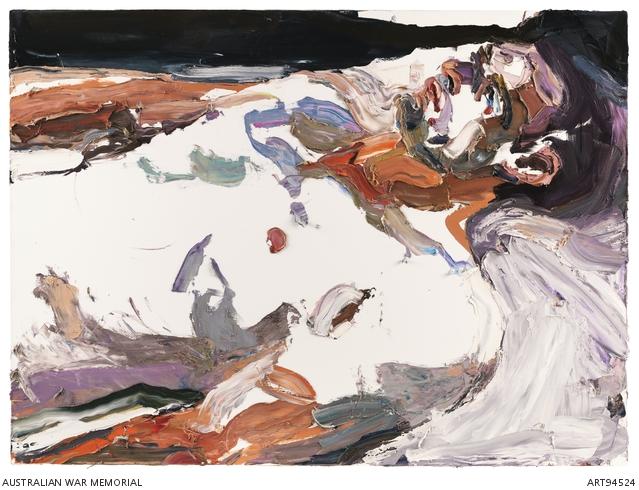
Patricia Piccinini (b. 1965)
Patricia Piccinini creates thought-provoking works blending hyperrealism with surreal elements to explore themes of biotechnology, ethics, and the boundaries of humanity.
Known for:
- The Comforter (2010)
Over the years, Australia has seen a rich history in art development in a rather short time. One thing is certain: Australia is poised to create more art in more interesting movements in the coming years.

